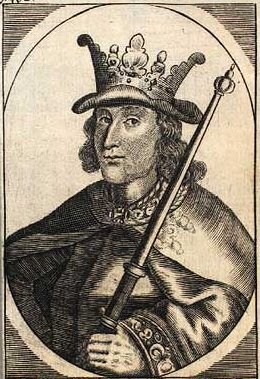Christopher I of Denmark facts for kids
Quick facts for kids Christopher I |
|||||
|---|---|---|---|---|---|
 |
|||||
| King of Denmark and the Wends | |||||
| Reign | 1252–1259 | ||||
| Coronation | Christmas Day 1252 | ||||
| Predecessor | Abel | ||||
| Successor | Eric V Klipping | ||||
| Born | 1219 | ||||
| Died | 29 May 1259 (aged 39–40) Ribe |
||||
| Burial | Ribe Cathedral | ||||
| Spouse | Margaret Sambiria | ||||
| Issue among others... |
Eric V Klipping | ||||
|
|||||
| House | Estridsen | ||||
| Father | Valdemar II of Denmark | ||||
| Mother | Berengaria of Portugal | ||||
Christopher I (born 1219, died May 29, 1259) was the King of Denmark from 1252 to 1259. He was the son of Valdemar II of Denmark and his wife, Berengaria of Portugal. Christopher became king after his older brother Abel of Denmark passed away in 1252. He was crowned king at Lund Cathedral on Christmas Day that same year.
Contents
Becoming King of Denmark
Christopher wanted to make sure his own sons would rule Denmark next. To do this, he tried to get his brother Eric IV Plovpenning declared a saint. Eric had been murdered, and Christopher blamed his other brother, Abel. If the Pope agreed Eric was a saint, it would mean Abel's sons could not become king. This was a way for Christopher, as a younger son, to keep the crown in his direct family line.
Challenges During His Reign
King Christopher faced many challenges during his time as ruler. He let Abel's son, Valdemar Abelsøn, become the Duke of Schleswig. This helped avoid a big civil war. However, it also led to many plots and betrayals against Christopher. Parts of southern Jutland, like Schleswig and Holstein, were not under the king's control for a while.
Christopher also had a powerful enemy in Jacob Erlandsen, the new Archbishop of Lund. The Archbishop was close to Abel's family. He often disagreed with the king about who had more power. King Christopher believed the church should pay taxes, just like other landowners. Archbishop Jacob refused. He even told farmers on church land not to serve in the king's army.
Archbishop Jacob was very wealthy and believed the church should be completely independent. He thought the government should have no say over church property or its people. To show his power, he even excommunicated the king. This meant the king was cut off from the church.
Conflicts and Uprisings
In 1256, Christopher made peace with the kings of Norway and Sweden. Their relationship had been difficult because of Abel's actions. The same year, and again in 1258, farmers rebelled against King Christopher. This happened because of a new property tax he introduced.
Archbishop Jacob continued to challenge the king. In 1257, he refused to accept Christopher's young son, Eric, as the rightful heir to the throne. He even threatened to excommunicate any bishop who crowned Prince Eric. This was too much for King Christopher. He ordered the Archbishop's own brother to arrest him.
Christopher wanted to humiliate the powerful Archbishop Jacob. He made him wear ordinary clothes and a silly hat with a fox tail. The Archbishop was paraded through the country. Then, he was chained and thrown into prison at Hagenskov. Archbishop Erlandsen had previously ordered that if he was imprisoned, bishops should stop all church services in the country. However, none of them did. Peder Bang, the Bishop of Roskilde, fled to Rügen. He convinced Chief Jaromar II to invade Zealand.
Christopher still tried to get his brother Eric IV declared a saint. But without Archbishop Jacob's support, it didn't happen. When Duke Valdemar died, King Christopher tried to stop Valdemar's brother, Eric Abelsøn, from becoming the new duke. Valdemar's widow encouraged some German counts to rebel. In the confusion, Christopher fled to Southern Jutland. He stayed with the Bishop of Ribe.
King Christopher died suddenly after taking Holy Communion. Some people at the time believed he was poisoned by an abbot named Arnfast. They thought this was revenge for how Christopher treated Archbishop Erlandsen and the church. Even though he was excommunicated, Christopher was buried in Ribe Cathedral on May 29, 1259. He may have died of natural causes. However, Christopher's supporters called him Krist-Offer, meaning "Christ's sacrifice." His son Eric became the next king, Eric V of Denmark.
Christopher's Legacy
During Christopher's rule, a new group called the Danehof was created. This was like a national council. It gave advice and helped with legal matters.
Christopher married Margaret Sambiria in 1248. She was the daughter of Count Sambor II of Pomerania. They had several children:
- King Eric V of Denmark (1249–1286)
- Niels (died December 21, 1259), who died young
- Valdemar, who also died young
- Matilda (1250–1299/1300), who married Albert III, Margrave of Brandenburg-Salzwedel
- Margaret (around 1257–1306), who married John II, Count of Holstein-Kiel


